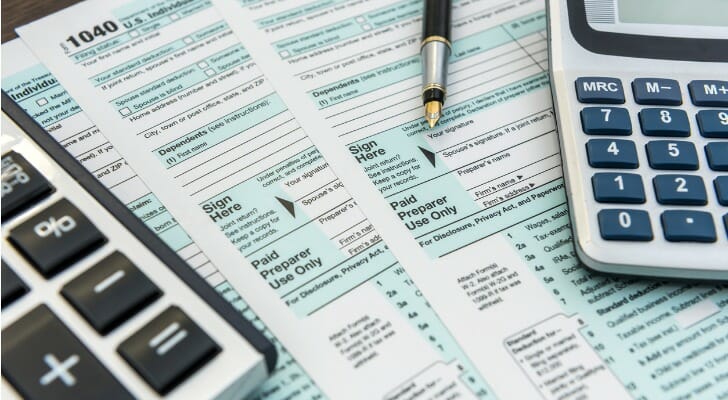The student loan interest tax deduction is for students and their parents who are repaying federal student financial aid. It’s the “above the line” adjustment to your adjusted gross income (AGI) if you have paid interest to a qualified loan program during 2023. It can be taken whether you itemize deductions or take the standard deduction. Here’s what you need to know about this deduction, when it can be applied and how to calculate your deduction.
A financial advisor can guide you as you seek to build out a comprehensive tax plan.
Student Loan Interest Deduction Basics
You get the full amount of your qualified interest deduction to your AGI since it is above the line and not an itemized deduction, though it can be taken whether you itemize deductions or not. The largest amount you can claim for a student loan interest deductible is $2,500 for 2023 (and remains the same in 2024), but that is limited by your income eligibility. You may have paid more interest than that during the year, but that is the limit of your claim.
If you are single, head of household or a qualifying widow(er), your student loan interest phase-out starts at $75,000 modified AGI and the phase-out ends at $90,000. If you are married you can make $150,000 before the phase-out begins. You can earn up to $180,000 which is the level at which the phase-out ends. Those phase-outs change in 2024 to be between $80,000 and $95,000 for single filers and between $165,000 and $195,000 for those who are married and filing jointly.
Keep in mind that the pandemic led to the March 2020 CARES Act, which paused student loan payments, froze interest rates at 0% and stopped debt collection until it expired. That extension ended on June 30, 2023, and payments resumed in October 2023.
Which Student Loans Qualify, Which Don’t?
The student loans that qualify for the interest waiver during the pandemic are any loans owned by the Department of Education. These are Direct Loans, subsidized and unsubsidized Stafford Loans, Parent and Graduate Plus Loans and consolidation loans.
The student loans that do not qualify for the interest waiver are many. They are the Federal Family Education Loans (FFEL) and the Perkins Loans if held commercially by lending institutions. If they are held by the Department of Education, they are also covered.
The only student loans that qualify for the student loan interest deduction are those that are for the benefit of you, your spouse or your dependent and spent on qualifying education expenses. Private loans or loans from an employee-sponsored plan are not eligible. The loan must be for an academic term and the student must be at least half-time to qualify.
Qualifying Education Expenses and Eligibility
Educational expenses must meet certain qualifications in order to qualify for this deduction. Qualified education expenses can include:
- Tuition
- Room and board
- Books, supplies and equipment
- Transportation
- Fees
If you are single, you are eligible for the student loan interest deduction if you file as a single person, head of household or as a qualifying widow(er). If you are married, you are eligible if you file a joint return. You are not eligible if you are married, filing separately. You can’t be listed as a dependent on someone else’s return. If your child has completed the loan applications, you aren’t eligible even if you make the payments.
Calculating Your Student Loan Interest Deduction
You get the amount of qualified interest you paid during 2023 from the organizations to whom you owe the interest on Form 1098-E. Depending on your loans, you may receive more than one Form 1098-E. Any lender to whom you paid $600 or more in interest in 2023 is required to send you this form.
You fill in the amount of your student loan interest deduction on Schedule 1, line 20, of the 2023 Internal Revenue Service (IRS) Form 1040. It will be the total of your interest from all your Forms 1098-E. Add that to any other entries from Schedule 1 and total on Line 22. Bring the total from Line 22 over to Form 1040 and complete Line 10A.
The result of this is that the student loan interest deduction will decrease your AGI, which will, in turn, reduce your tax liability.
Bottom Line
The student loan interest deduction is valuable to taxpayers with student loan debt. That’s because it is a deduction written off before your AGI is calculated. You get the benefit of the full deduction to which you are entitled. Individuals who do not itemize their deductions also receive the full benefit of the student loan interest deduction to which they are entitled.
Tips on Filing Your Taxes
- A financial advisor can help you identify all of the right deductions for your own tax situation. Finding a financial advisor doesn’t have to be hard. Finding a financial advisor doesn’t have to be hard. SmartAsset’s free tool matches you with up to three vetted financial advisors who serve your area, and you can have a free introductory call with your advisor matches to decide which one you feel is right for you. If you’re ready to find an advisor who can help you achieve your financial goals, get started now.
- Want to see what you could owe this year? Use SmartAsset’s free income tax calculator.
Photo credit: ©iStock.com/SDI Productions, ©iStock.com/fizkes, ©iStock.com/fizkes


